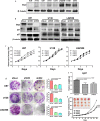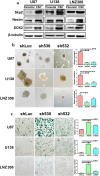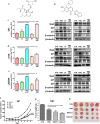Skp2 modulates proliferation, senescence and tumorigenesis of glioma
- PMID: 32165861
- PMCID: PMC7059397
- DOI: 10.1186/s12935-020-1144-z
Skp2 modulates proliferation, senescence and tumorigenesis of glioma
Abstract
Background: Gliomas represent the largest class of primary central nervous system neoplasms, many subtypes of which exhibit poor prognoses. Surgery followed by radiotherapy and chemotherapy has been used as a standard strategy but yielded unsatisfactory improvements in patient survival outcomes. The S-phase kinase protein 2 (Skp2), a critical component of the E3-ligase SCF complex, has been documented in tumorigenesis in various cancer types but its role in glioma has yet to be fully clarified. In this study, we investigated the function of Skp2 in the proliferation, stem cell maintenance, and drug sensitivity to temozolomide (TMZ) of glioma.
Methods: To investigate the role of Skp2 in the prognosis of patients with glioma, we first analyzed data in databases TCGA and GTEx. To further clarify the effect of Skp2 on glioma cell proliferation, we suppressed its level in glioblastoma (GBM) cell lines through knockdown and small molecule inhibitors (lovastatin and SZL-P1-41). We then detected cell growth, colony formation, sphere formation, drug sensitivity, and in vivo tumor formation in xenograft mice model.
Results: Skp2 mRNA level was higher in both low-grade glioma and GBM than normal brain tissues. The knockdown of Skp2 increased cell sensitivity to TMZ, decreased cell proliferation and tumorigenesis. In addition, Skp2 level was found increased upon stem cells enriching, while the knockdown of Skp2 led to reduced sphere numbers. Downregulation of Skp2 also induced senescence. Repurposing of lovastatin and novel compound SZL-P1-41 suppressed Skp2 effectively, and enhanced glioma cell sensitivity to TMZ in vitro and in vivo.
Conclusion: Our data demonstrated that Skp2 modulated glioma cell proliferation in vitro and in vivo, stem cell maintenance, and cell sensitivity to TMZ, which indicated that Skp2 could be a potential target for long-term treatment.
Keywords: Glioma; Glioma stem-like cells; Lovastatin; S-phase kinase-associated protein 2 (Skp2); SZL-P1-41.
© The Author(s) 2020.
Conflict of interest statement
Competing interestsThe authors declare that they have no competing interests.
Figures





References
-
- Jia T, Zhang L, Duan Y, Zhang M, Wang G, Zhang J, Zhao Z. The differential susceptibilities of MCF-7 and MDA-MB-231 cells to the cytotoxic effects of curcumin are associated with the PI3K/Akt-SKP2-Cip/Kips pathway. Cancer Cell Int. 2014;14(1):126. doi: 10.1186/s12935-014-0126-4. - DOI - PMC - PubMed
LinkOut - more resources
Full Text Sources
Miscellaneous

